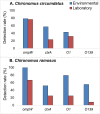Identification of chironomid species as natural reservoirs of toxigenic Vibrio cholerae strains with pandemic potential
- PMID: 33362241
- PMCID: PMC7757795
- DOI: 10.1371/journal.pntd.0008959
Identification of chironomid species as natural reservoirs of toxigenic Vibrio cholerae strains with pandemic potential
Abstract
Vibrio cholerae causes the fatal cholera diarrhea. Chironomids (Diptera; Chironomidae) are abundant in freshwater aquatic habitats and estuaries and are natural reservoirs of V. cholerae. Until now, only the non-O1/O139 serogroups of V. cholerae were identified in chironomids. Here, we explored whether chironomids are natural reservoirs of V. cholerae O1/O139 serogroups, which are associated with cholera endemics and pandemics. All four life stages of chironomids were sampled from two rivers, and a laboratory culture in Pune, India, and from a pond in Israel. In total, we analyzed 223 chironomid samples. The presence of V. cholerae O1/O139 serogroups was verified using molecular tools. Nine chironomid species were identified; of them, Chironomus circumdatus was the most abundant. The presence of V. cholerae serogroup O1 and the cholera toxin genes were detected in samples from all chironomid species. However, serogroup O139 was detected in only two chironomid species. Besides PCR to detect specific genes, a metagenomic analysis that was performed in three selected C. ramosus larvae, identified a list of virulence genes associated with V. cholerae. The findings provide evidence that chironomids are natural reservoirs of toxigenic V. cholerae O1/O139. Chironomid populations and V. cholerae show biannual peak patterns. A similar pattern is found for cholera epidemics in the Bengal Delta region. Thus, we hypothesize that monitoring chironomids in endemic areas of the disease may provide a novel tool for predicting and preventing cholera epidemics. Moreover, serogroup O139 was detected only in two chironomid species that have a restricted distribution in the Indian subcontinent, possibly explaining why the distribution of the O139 serogroup is limited.
Conflict of interest statement
The authors have declared that no competing interests exist.
Figures



Similar articles
-
Dependent population dynamics between chironomids (nonbiting midges) and Vibrio cholerae.FEMS Microbiol Ecol. 2006 Jan;55(1):98-104. doi: 10.1111/j.1574-6941.2005.00020.x. FEMS Microbiol Ecol. 2006. PMID: 16420618
-
Chironomid egg masses as a natural reservoir of Vibrio cholerae non-O1 and non-O139 in freshwater habitats.Microb Ecol. 2004 May;47(4):341-9. doi: 10.1007/s00248-003-2007-6. Epub 2003 Dec 23. Microb Ecol. 2004. PMID: 14681736
-
Molecular analysis of Vibrio cholerae O1, O139, non-O1, and non-O139 strains: clonal relationships between clinical and environmental isolates.Appl Environ Microbiol. 2001 Feb;67(2):910-21. doi: 10.1128/AEM.67.2.910-921.2001. Appl Environ Microbiol. 2001. PMID: 11157262 Free PMC article.
-
Epidemiology & molecular biology of Vibrio cholerae O139 Bengal.Indian J Med Res. 1996 Jul;104:14-27. Indian J Med Res. 1996. PMID: 8783504 Review.
-
Emergence of a new cholera pandemic: molecular analysis of virulence determinants in Vibrio cholerae O139 and development of a live vaccine prototype.J Infect Dis. 1994 Aug;170(2):278-83. doi: 10.1093/infdis/170.2.278. J Infect Dis. 1994. PMID: 8035010 Review.
Cited by
-
Vibrio cholerae Invasion Dynamics of the Chironomid Host Are Strongly Influenced by Aquatic Cell Density and Can Vary by Strain.Microbiol Spectr. 2023 Jun 15;11(3):e0265222. doi: 10.1128/spectrum.02652-22. Epub 2023 Apr 19. Microbiol Spectr. 2023. PMID: 37074192 Free PMC article.
-
Environmental Reservoirs of Pathogenic Vibrio spp. and Their Role in Disease: The List Keeps Expanding.Adv Exp Med Biol. 2023;1404:99-126. doi: 10.1007/978-3-031-22997-8_6. Adv Exp Med Biol. 2023. PMID: 36792873 Review.
-
Comparative Microbiota Composition Across Developmental Stages of Natural and Laboratory-Reared Chironomus circumdatus Populations From India.Front Microbiol. 2021 Nov 26;12:746830. doi: 10.3389/fmicb.2021.746830. eCollection 2021. Front Microbiol. 2021. PMID: 34899634 Free PMC article.
-
Chironomid association with Vibrio cholerae.Microbiol Spectr. 2024 Jan 11;12(1):e0256723. doi: 10.1128/spectrum.02567-23. Epub 2023 Dec 7. Microbiol Spectr. 2024. PMID: 38059589 Free PMC article. No abstract available.
-
Comprehensive taxonomic identification of microbial species in metagenomic data using SingleM and Sandpiper.Nat Biotechnol. 2025 Jul 16. doi: 10.1038/s41587-025-02738-1. Online ahead of print. Nat Biotechnol. 2025. PMID: 40670710
References
-
- Thorat L, Nath, Bimalendu B. Trends in Chironomid Research. Chironomus Newsletteron Chironomidae Res. 2010;23: 34–35.
-
- Broza M, Halpern M, Inbar M. Non-biting midges (Diptera; chironomidae) in waste stabilization ponds: An intensifying nuisance in Israel. Wat Sci Technol. 2000;42:71–74.
Publication types
MeSH terms
Substances
LinkOut - more resources
Full Text Sources
Medical

